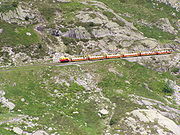
Petit train d'Artouste
Encyclopedia


Narrow gauge
A narrow gauge railway is a railway that has a track gauge narrower than the of standard gauge railways. Most existing narrow gauge railways have gauges of between and .- Overview :...
tourist railway situated in the French
France
The French Republic , The French Republic , The French Republic , (commonly known as France , is a unitary semi-presidential republic in Western Europe with several overseas territories and islands located on other continents and in the Indian, Pacific, and Atlantic oceans. Metropolitan France...
Pyrenees
Pyrenees
The Pyrenees is a range of mountains in southwest Europe that forms a natural border between France and Spain...
close to the Spanish
Spain
Spain , officially the Kingdom of Spain languages]] under the European Charter for Regional or Minority Languages. In each of these, Spain's official name is as follows:;;;;;;), is a country and member state of the European Union located in southwestern Europe on the Iberian Peninsula...
border and some 55 km (34.2 mi) south of the town of Pau. The line runs high above the headwaters of the Gave d'Ossau
Gave d'Ossau
The Gave d'Ossau is the torrential river flowing through the Ossau Valley, one of the three main valleys of the High-Béarn , in the Southwest of France....
, and provides access to the Lac d'Ossau, an artificial lake in the mountains at an altitude of over 2000 m (6,562 ft).
The petit train is reached by a télécabine
Gondola lift
A gondola lift is a type of aerial lift, normally called a cable car, which is supported and propelled by cables from above. It consists of a loop of steel cable that is strung between two stations, sometimes over intermediate supporting towers. The cable is driven by a bullwheel in a terminal,...
from a lower station at Artouste-Fabrèges, on the Lac de Fabrèges
Lac de Fabrèges
Lac de Fabrèges is a lake in Pyrénées-Atlantiques, France. At an elevation of 1241 m, its surface area is 0.54 km²....
in the valley of the Gave du Brousset. This lower station is at an altitude of 1240 m (4,068 ft) and accessible by road. The télécabine climbs to an upper station (known as Ossau2000) at an altitude of 1920 m (6,299 ft), where passengers change to the petit train. After leaving Ossau2000, the line runs through a 315 m (1,033 ft) tunnel, crossing under the ridge to reach a point high above the valley of the Gave de Soussouéou, another of the Gave d'Ossau's tributaries. From here the line runs along a twisting and vertiginous ledge above that valley until it reaches the dam of the Lac d'Artouste.
The line is 10 km (6.2 mi) long and is built to a gauge of . Trains consist of 6 12-seat carriages pulled by a diesel locomotive
Diesel locomotive
A diesel locomotive is a type of railroad locomotive in which the prime mover is a diesel engine, a reciprocating engine operating on the Diesel cycle as invented by Dr. Rudolf Diesel...
, and operate from late May or early July until the end of September or early October. They are subject to a maximum speed of 15 km/h (9.3 mph) and the end to end journey takes just under one hour. On busy days, up to 10 trains are used providing 3 departures per hour, whilst at other times departures are hourly. Trains depart from 08.30 until 14:30 or later in the high season.
The line was originally constructed for the Compagnie des Chemins de Fer du Midi
Chemin de Fer du Midi
The Chemin de Fer du Midi, often abbreviated to CF du Midi, was an early French railway company.In 1934 it merged with the Chemin de Fer de Paris à Orléans to become part of the Chemin de Fer de Paris à Orléans et du Midi ....
(CFM), the then main line railway operator in the area to the north of the Pyrenees. As part of a program of electrifying these lines, the CFM constructed a series of hydro-electric
Hydroelectricity
Hydroelectricity is the term referring to electricity generated by hydropower; the production of electrical power through the use of the gravitational force of falling or flowing water. It is the most widely used form of renewable energy...
power station
Power station
A power station is an industrial facility for the generation of electric energy....
s in the valley of the Ossau between the years 1920 and 1932. Significant civil engineering works were required in order to provide access to these works, and included the line now used by the petit train. Once this work was finished, the CFM recognised the tourist potential of the line, and the first tourist trains were run.
External links
- Official web site of the Petit train d'Artouste (in French)

